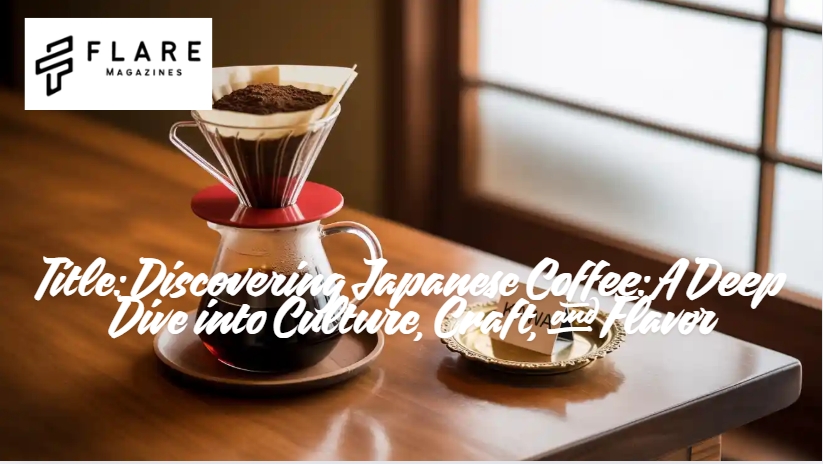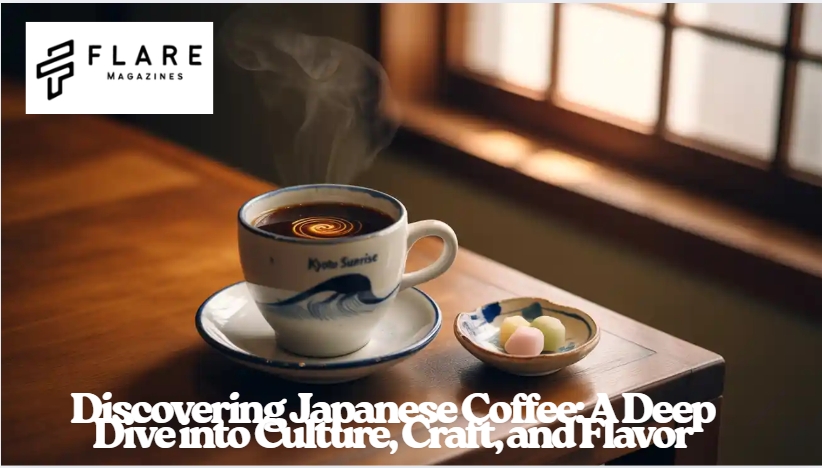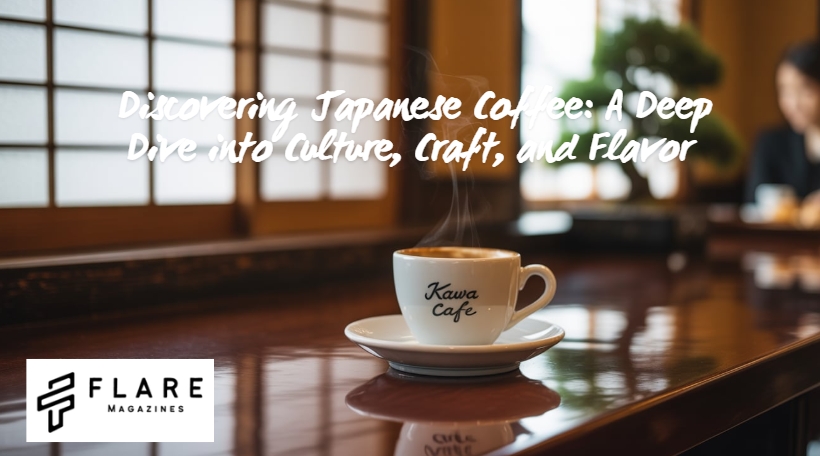In the bustling cities and quiet corners of Japan, there’s a deeply rooted ritual that awakens both the senses and the soul — Japanese coffee. It’s more than just a beverage; it’s a cultural expression, a meditative moment, and a work of precision art. Unlike the hurried drip coffees of the West, Japanese coffee is slow, intentional, and brewed with unmatched attention to detail. Whether it’s the elegant pour-over using a Hario V60, the mesmerizing siphon method, or the smooth Kyoto-style cold brew, every sip tells a story of discipline, design, and devotion.
Across Tokyo, Kyoto, and even now in American cities like New York and Los Angeles, Japanese coffee is captivating hearts with its clean flavors and thoughtful preparation. It isn’t just about caffeine — it’s about connection. As the world seeks more mindful experiences, Japanese coffee offers a beautiful pause, inviting you to savor time, taste, and tranquility in every cup.
The Soulful Aroma of Japanese Coffee
There’s something magical brewing in the heart of Japan, and it goes beyond sushi, cherry blossoms, or anime. It’s Japanese coffee — a soulful blend of tradition, precision, and innovation. When you sip a cup of Japanese coffee, you’re not just drinking caffeine; you’re tasting heritage, philosophy, and artistry.
This article explores every layer of Japanese coffee, from the streets of Tokyo to the trend-setting cafes of New York. Whether you’re a coffee aficionado or a curious traveler, this guide will transport you into the aromatic universe of Japanese coffee
The Origins of Japanese Coffee Culture
Japanese coffee culture has its roots in the Meiji period when Western influences started shaping Japan’s food and beverage scene. While tea remained dominant, coffee began carving a niche, especially among the intellectual class.
By the 1960s, the kissaten (traditional Japanese coffee houses) became a haven for students, artists, and deep thinkers. These cozy, smoke-filled spaces were more than just cafes; they were cultural centers where ideas brewed alongside coffee.
Today, Japanese coffee has evolved into a refined, almost spiritual experience — celebrated for its precision brewing and exceptional bean quality
What Makes Japanese Coffee Unique?
Why is Japanese coffee gaining such traction globally? The answer lies in the details. Unlike mass-produced coffee in other parts of the world, Japanese coffee emphasizes:
- Precision: From water temperature to bean measurement, everything is exact.
- Patience: Pour-over brewing techniques like the Hario V60 require a slow and thoughtful approach.
- Presentation: Every cup of Japanese coffee is treated like a piece of art.
This obsessive attention to detail results in coffee that is clean, balanced, and deeply satisfying.

Brewing Techniques: The Art of Making Japanese Coffee
When it comes to brewing Japanese coffee, there are several signature methods that define the craft:
1. Hario V60
The V60 pour-over is perhaps the most iconic Japanese brewing method. With its spiral ridges and cone shape, it allows optimal water flow and flavor extraction.
2. Siphon Brewing
Straight out of a chemistry lab, siphon brewing involves vacuum pressure to extract a delicate, tea-like cup of coffee. It’s dramatic, elegant, and purely Japanese coffee at its most scientific.
3. Cold Brew (Kyoto-Style)
Kyoto-style cold brew drips water slowly over grounds for several hours, producing a sweet, smooth, and less acidic cup — perfect for hot summers and gaining popularity across the USA.
Japanese Coffee Beans: Sourcing and Roasting
Though Japan doesn’t grow coffee beans domestically in large quantities, it imports some of the finest beans from Ethiopia, Colombia, and Brazil. What sets Japanese coffee apart is how these beans are roasted and treated.
- Light to Medium Roasts: Highlighting natural bean flavors rather than masking them.
- Single Origin Focus: Many Japanese roasters focus on single-origin beans to maintain purity.
- Artisanal Roasting: Small-batch roasting ensures quality and consistency.
Brands like Blue Bottle Japan, Maruyama Coffee, and Onibus Coffee have set new benchmarks in roasting standards.
The Kissaten Experience: A Cultural Ritual
To understand Japanese coffee, one must step into a kissaten. These traditional coffee houses are worlds apart from modern cafes. With jazz playing in the background, antique decor, and a slow-paced environment, kissatens provide a sanctuary for reflection.
Every cup of Japanese coffee served here is a ritual — brewed individually, sometimes taking up to 10 minutes, and often accompanied by a slice of sponge cake or toast.
Japanese Coffee in the USA: A Rising Trend
The influence of Japanese coffee is now firmly rooted in American cities like Los Angeles, New York, and San Francisco. Cafes such as %Arabica, Blue Bottle (founded in Oakland but deeply influenced by Japanese methods), and even local boutique cafes are adopting Japanese brewing techniques.
Why the craze?
- Aesthetic appeal
- Clean flavor profiles
- Mindful brewing experience
USA consumers, increasingly interested in wellness and mindfulness, are embracing Japanese coffee as a healthier, more thoughtful alternative to their caffeine fix.
Famous Japanese Coffee Brands and Cafes
Let’s dive into some of the most renowned names that have put Japanese coffee on the global map:
- Ueshima Coffee Company: Japan’s leading coffee chain known for canned coffee innovations.
- %Arabica: Minimalist aesthetics, world-class beans, and iconic branding.
- Hoshino Coffee: Known for hand-dripped coffee and souffle pancakes.
- Blue Bottle Japan: A symbol of East meets West coffee excellence.

Health Benefits of Japanese Coffee
Yes, Japanese coffee is not only a delight to the senses but also a healthy choice. Thanks to its brewing style and clean beans, it offers:
- Lower Acidity: Gentle on the stomach.
- No Additives: Focus is on natural taste, without sugars or creams.
- Antioxidants: Like all coffee, it’s rich in antioxidants that fight inflammation.
How to Brew Japanese Coffee at Home
Want to bring the elegance of Japanese coffee into your own kitchen? Here’s how:
- Choose High-Quality Beans (preferably single origin)
- Grind Fresh: Medium-fine for pour-over
- Use a Gooseneck Kettle for better control
- Practice Pouring Technique: Small circles, even saturation
- Patience Is Key: Let the bloom phase settle before full pour
The Role of Design in Japanese Coffee Culture
From the architecture of cafes to the design of packaging and cups, Japanese coffee takes aesthetics seriously. The minimalism, precision, and attention to negative space all mirror Japanese art principles.
Even the tools — the V60, ceramic drippers, glass servers — are as beautiful as they are functional.
Coffee Tourism in Japan
Planning a vacation? Make sure your itinerary includes Japanese coffee hotspots like:
- Tokyo: Onibus Coffee, Koffee Mameya
- Kyoto: %Arabica, Weekenders Coffee
- Osaka: Lilo Coffee Roasters
“Vacations to go” should always include at least one morning sipping Japanese coffee in a local kissaten while watching the world slow down.

Conclusion: Why Japanese Coffee Deserves Your Cup
In a fast-paced world, Japanese coffee offers something rare: a moment of calm, focus, and intentionality. It invites you to pause, breathe, and appreciate the flavor in every drop.
So whether you’re sipping it in a Kyoto back alley, a Brooklyn loft, or your own kitchen, Japanese coffee brings you closer to mindfulness, tradition, and beauty.
Let this be your sign to take a break, brew a cup, and taste the difference.
FAQs
What is Japanese style coffee?
Japanese style coffee refers to precise brewing methods like pour-over or siphon, focusing on clarity, flavor balance, and presentation.
What is special about Japanese coffee?
Japanese coffee stands out for its attention to detail, clean taste, minimalist aesthetics, and deeply cultural brewing techniques.
Why is Gen Z obsessed with iced coffee?
Gen Z loves iced coffee for its refreshing taste, aesthetic appeal, and how well it fits into their fast-paced, social media-driven lifestyle.
Is Japanese coffee strong?
Japanese coffee is typically smooth and balanced, not overly strong, though the flavor depth can be intense depending on the roast.
What is the no. 1 coffee in Japan?
UCC (Ueshima Coffee Company) is one of Japan’s most popular and trusted coffee brands, known for its canned and drip coffee products.
Why is Japanese coffee so smooth?
The smoothness comes from light to medium roasting, high-quality beans, and slow, controlled brewing methods like pour-over and siphon.

